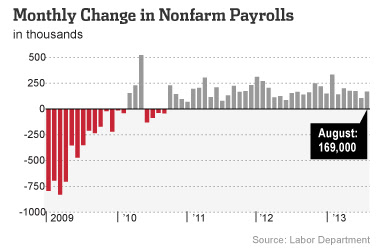From
Barron's
Streetwise |
SATURDAY, AUGUST 31, 2013
Not Your Typical Selloff
By
KOPIN TAN
Stocks ran up 54% in less than two years without a 10% correction, and now uncertainties loom.
SO, IS THIS A BUYING OPPORTUNITY?
Webster's defines retreat as a withdrawal to a position of safety, and U.S. stocks have retreated two of the past three months, with August delivering the biggest monthly setback since May 2012. But let's not mistake this buyers' strike for a flight from risk.
Since its Aug. 2 peak, the Standard & Poor's 500 has pulled back 4.5% while gold rallied. Yet investors aren't exactly dumping their riskiest, priciest bets, notes Justin Walters of Bespoke Investment Group, who divided the 500-stock benchmark into 10 groups of 50 stocks based on various criteria. He found, for instance, that the 50 stocks with the richest price/earnings valuations had declined just 3.4%, the least among the 10 deciles. The 50 stocks paying no dividend lost just 3.9%, versus 4.9% for the 50 proffering the most generous yields. Heavily shorted stocks outperformed. Says Walters: "This is the type of relative performance you would see during a market rally, and not a market decline."
Individuals also seem to be doing more of the selling, and the 50 stocks most heavily held by institutions fell just 3.5%, versus 4.9% for the 50 with the least institutional ownership. Bulls are rethinking their infatuation with U.S. exposure: The 50 stocks with the most foreign revenues fell just 3.2%, versus 5.2% for those with the most U.S. sales. Meanwhile, economically sensitive sectors continue to hold up. More than half of all industrials, materials and technology stocks hovered above their 50-day averages—a feat managed by less than 15% in the utilities and consumer-staples camps.
So, what's giving investors pause? The nervous hear rustling everywhere, and the ruckus over Syria hasn't helped. But Syria isn't a big oil producer and controls no key transport hubs or routes, and U.S. allies like Saudi Arabia conceivably can offset any oil-production cuts from Syrian allies like Iran. No, our hesitation owes more to the fact that stocks ran up 56% in less than two years without as much as a 10% correction, and now the autumn looms with budget debates, uncertain policy, and waning central-bank support.
Michael Hartnett, Bank of America Merrill Lynch's chief investment strategist, highlighted themes like the great rotation of bonds into stocks and the peak in central-bank liquidity well before many of his peers. Now that the consensus has caught up to these views, he's watching a shortlist of potential risks he has nicknamed "Crash"—conflict in policy and among governments, rates, Asia, speculative froth, and housing—that could turn this buyers' strike into a more contagious selloff.
For example, Middle East conflict that drives Brent crude oil above $125 a barrel could pressure stocks, the same way oil prices above that threshold did in 2008 and 2011 (Brent was near $114 recently). Signs of speculative fervor like record margin debt would be troubling, as is evidence of rising borrowing costs thwarting the housing recovery. "The opiate of investors has been central-bank liquidity," with 520 rate cuts and $11.5 trillion from global central banks over the past six years aimed at holding rates down, Hartnett writes. This leaves stocks vulnerable to central-bank error, or another big bond selloff that sends rates spiking. "We would be worried should rising rates coincide with weaker bank stocks."
Read more >>






